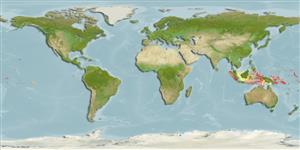Common names from other countries
>
Gobiiformes (Gobies) >
Gobiidae (Gobies) > Gobiinae
Etymology: Eviota: No etymology given, suggested by Christopher Scharpt: from Latin 'eu' for 'true' and 'iota' for anything very small, in combination 'truly very small' referring to it as being the smallest vertebrate at the time it has benn described by Jenkins (thus, making the suggestion by Scharpt plausible..
More on authors: Jewett & Lachner.
Environment: milieu / climate zone / depth range / distribution range
Ökologie
seewasser riff-verbunden; tiefenbereich ? - 35 m (Ref. 86942). Tropical; 7°N - 11°S
Indo-Pacific: Christmas Island in the eastern Indian Ocean to New Caledonia, Solomon Islands, Fiji, Tonga and French Polynesia (Austral Islands); north to Japan (Okinawa and Ryukyu Islands); south to Indonesia (Sulawesi, Lesser Sundas, Banda, West Papua); including Micronesia (Palau, FSM [Pohnpei], and Kiribati).
Size / Gewicht / Alter
Maturity: Lm ? range ? - ? cm
Max length : 1.5 cm SL Männchen/unbestimmt; (Ref. 1602); 1.2 cm SL (female)
Rückenflossenstacheln (insgesamt): 7; Rückenflossenweichstrahlen (insgesamt): 7-9; Afterflossenstacheln 1; Afterflossenweichstrahlen: 8 - 9. Characterized by semi-transparent body with 6-7 broad brown bars or blotches on side; head with white marks dorsally; longitudinal scale series 23-25; ctenoid scales, absent on head, nape, chest and pectoral fin base; separated pelvic fins, thin membrane joining bases; 7-11 branches of fourth pelvic ray; depth of body 4.5-5.0 in SL (Ref. 90102).
Occurs from less than 5 to between 8 and 24 m. Solitary, rests on bottom. Inhabits exposed coastal reefs and outer slopes (Ref 90102).
Life cycle and mating behavior
Geschlechtsreife | Fortpflanzung | Ablaichen | Eier | Fecundity | Larven
Greenfield, D.W. and R. Winterbottom, 2016. A key to the dwarfgoby species (Teleostei: Gobiidae: Eviota) described between 1871 and 2016. J. Ocean Sci. Found. 24:35-90. (Ref. 113727)
IUCN Rote Liste Status (Ref. 130435)
CITES (Ref. 128078)
Not Evaluated
Bedrohung für Menschen
Harmless
Nutzung durch Menschen
Mehr Information
NamenSynonymeMetabolismusRäuberÖkotoxikologieFortpflanzungGeschlechtsreifeAblaichenFecundityEierEientwicklung
ReferenzenAquakulturAquakultur ProfilZuchtlinienGenetikElectrophoresesVererbbarkeitKrankheitenVerarbeitungMass conversion
Tools
Zusatzinformationen
Download XML
Internet Quellen
Estimates based on models
Preferred temperature (Ref.
115969): 28.2 - 29.4, mean 28.9 (based on 744 cells).
Phylogenetic diversity index (Ref.
82804): PD
50 = 0.5000 [Uniqueness, from 0.5 = low to 2.0 = high].
Bayesian length-weight: a=0.00708 (0.00333 - 0.01504), b=3.09 (2.92 - 3.26), in cm Total Length, based on LWR estimates for this (Sub)family-body shape (Ref.
93245).
Trophic level (Ref.
69278): 3.0 ±0.3 se; based on size and trophs of closest relatives
Widerstandsfähigkeit (Ref.
120179): hoch, Verdopplung der Population dauert weniger als 15 Monate. (Preliminary K or Fecundity.).
Fishing Vulnerability (Ref.
59153): Low vulnerability (10 of 100).
